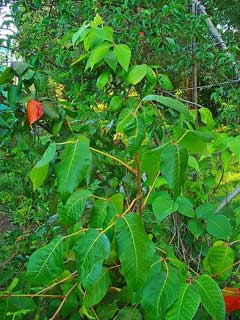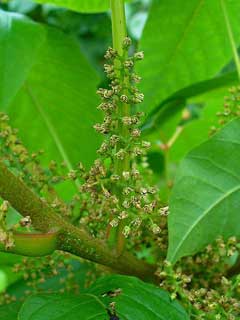 |
|
http://commons.wikimedia.org/wiki/User:Llez |
 |
| http://commons.wikimedia.org/wiki/User:Llez |
Translate this page:
Summary
Physical Characteristics

 Rhus radicans is a deciduous Climber growing to 2.5 m (8ft 2in) at a fast rate.
Rhus radicans is a deciduous Climber growing to 2.5 m (8ft 2in) at a fast rate.
See above for USDA hardiness. It is hardy to UK zone 5 and is not frost tender. It is in flower from May to June, and the seeds ripen from September to November. The species is dioecious (individual flowers are either male or female, but only one sex is to be found on any one plant so both male and female plants must be grown if seed is required). and is pollinated by Bees. The plant is not self-fertile.
Suitable for: light (sandy), medium (loamy) and heavy (clay) soils and prefers well-drained soil. Suitable pH: mildly acid, neutral and basic (mildly alkaline) soils. It cannot grow in the shade. It prefers moist soil.
UK Hardiness Map
US Hardiness Map
Synonyms
R. toxicodendron. non L. Toxicodendron radicans. (L.)Kuntze. T. vulgare.
Plant Habitats
Woodland Garden Sunny Edge; Dappled Shade;
Edible Uses
Edible Parts: Oil
Edible Uses: Oil
None known
References More on Edible Uses
Medicinal Uses
Plants For A Future can not take any responsibility for any adverse effects from the use of plants. Always seek advice from a professional before using a plant medicinally.
Hepatic Skin Tonic
Poison ivy has occasionally been used medicinally, though it is an extremely poisonous plant and great caution should be exercised. Any herbal use should only be undertaken under the supervision of a qualified practitioner. See also the notes above on toxicity. This plant has been used in the past by physicians in the treatment of paralysis and liver disorders[222]. A decoction of the leaves has been used as a tonic and rejuvenator[257]. The whole or the broken leaves have been rubbed over the skin to treat boils and skin eruptions[257]. The leaves have been rubbed on skin that has been affected by a poison ivy reaction[257].
References More on Medicinal Uses
The Bookshop: Edible Plant Books
Our Latest books on Perennial Plants For Food Forests and Permaculture Gardens in paperback or digital formats.

Edible Tropical Plants
Food Forest Plants for Hotter Conditions: 250+ Plants For Tropical Food Forests & Permaculture Gardens.
More

Edible Temperate Plants
Plants for Your Food Forest: 500 Plants for Temperate Food Forests & Permaculture Gardens.
More

More Books
PFAF have eight books available in paperback and digital formats. Browse the shop for more information.
Shop Now
Other Uses
Dye Ink Mordant Oil
The leaves are rich in tannin. They can be collected as they fall in the autumn and used as a brown dye or as a mordant[169]. An oil is extracted from the seeds[4]. It attains a tallow-like consistency on standing and is used to make candles. These burn brilliantly, though they emit a pungent smoke[4]. An excellent marking ink is obtained from this plant[11].
Special Uses
References More on Other Uses
Cultivation details
Succeeds in a well-drained fertile soil in full sun[11, 200]. The young growth in spring can be damaged by late frosts. A fast-growing but short-lived species in the wild[22]. It has brittle branches and these can be broken off in strong winds[200]. Plants are also susceptible to coral spot fungus[11]. Plants in this genus are notably resistant to honey fungus[200]. The plant has a semi-climbing habit and produces aerial roots[11], and occasionally reaches the size of a small tree[229]. Many of the species in this genus, including this one, are highly toxic and can also cause severe irritation to the skin of some people, whilst other species are not poisonous. It is relatively simple to distinguish which is which, the poisonous species have axillary panicles and smooth fruits whilst non-poisonous species have compound terminal panicles and fruits covered with acid crimson hairs[1, 4]. The toxic species are sometimes separated into their own genus, Toxicodendron, by some botanists[200]. Dioecious. Male and female plants must be grown if seed is required.
References Carbon Farming Information and Carbon Sequestration Information
Temperature Converter
Type a value in the Celsius field to convert the value to Fahrenheit:
Fahrenheit:
The PFAF Bookshop
Plants For A Future have a number of books available in paperback and digital form. Book titles include Edible Plants, Edible Perennials, Edible Trees,Edible Shrubs, Woodland Gardening, and Temperate Food Forest Plants. Our new book is Food Forest Plants For Hotter Conditions (Tropical and Sub-Tropical).
Shop Now
Plant Propagation
Seed - best sown in a cold frame as soon as it is ripe. Pre-soak the seed for 24 hours in hot water (starting at a temperature of 80 - 90c and allowing it to cool) prior to sowing in order to leach out any germination inhibitors[200]. The stored seed also needs hot water treatment and can be sown in early spring in a cold frame[200]. When they are large enough to handle, prick the seedlings out into individual pots and grow them on in the greenhouse for their first winter. Plant them out into their permanent positions in late spring or early summer, after the last expected frosts. Cuttings of half-ripe wood, 10cm with a heel, July/August in a frame[200]. Root cuttings 4cm long taken in December and potted up vertically in a greenhouse. Good percentage[78, 200]. Suckers in late autumn to winter[200].
Other Names
If available other names are mentioned here
Native Range
NORTHERN AMERICA: Canada (Nova Scotia), United States (Connecticut, Maine (south), Massachusetts, New Hampshire, New Jersey, New York (east), Pennsylvania, Rhode Island, Vermont, West Virginia, Alabama, Arkansas, Delaware, Florida, Georgia, Kentucky, Louisiana, Maryland, Mississippi, North Carolina, South Carolina, Tennessee, Virginia, Texas) SOUTHERN AMERICA: Bahamas, Bermuda
Weed Potential
Right plant wrong place. We are currently updating this section.
Please note that a plant may be invasive in one area but may not in your area so it's worth checking.
Conservation Status
IUCN Red List of Threatened Plants Status :

| Related Plants
|
| Latin Name | Common Name | Habit | Height | Hardiness | Growth | Soil | Shade | Moisture | Edible | Medicinal | Other |
| Rhus ambigua | | Climber | 0.0 |
6-9
| | LMH | SN | M | 0 | 0 | 2 |
| Rhus aromatica | Lemon Sumach, Fragrant sumac | Shrub | 1.2 |
3-9
| S | LMH | N | DM | 4 | 2 | 2 |
| Rhus chinensis | Chinese Gall, Chinese sumac | Tree | 6.0 |
7-10
| | LMH | N | M | 2 | 3 | 2 |
| Rhus copallina | Dwarf Sumach, Winged sumac, Flameleaf Sumac, Winged Sumac, Shining Sumac | Shrub | 2.0 |
4-10
| F | LMH | N | DM | 4 | 2 | 3 |
| Rhus coriaria | Elm-Leaved Sumach, Sicilian sumac | Shrub | 3.0 |
8-11
| M | LMH | N | DM | 2 | 1 | 2 |
| Rhus diversiloba | Western Poison Oak, Pacific poison oak | Shrub | 2.5 |
4-8
| | LMH | N | M | 0 | 2 | 2 |
| Rhus glabra | Smooth Sumach | Shrub | 3.0 |
3-9
| M | LMH | N | DM | 4 | 3 | 3 |
| Rhus integrifolia | Lemonade Berry, Lemonade sumac | Shrub | 2.0 |
8-10
| M | LMH | N | DM | 2 | 0 | 2 |
| Rhus microphylla | Desert Sumach, Littleleaf sumac | Shrub | 2.0 |
8-11
| | LMH | N | D | 2 | 0 | 2 |
| Rhus ovata | Sugar Bush, Sugar sumac | Shrub | 2.0 |
8-11
| | LM | N | DM | 2 | 1 | 2 |
| Rhus potaninii | | Tree | 12.0 |
4-8
| | LMH | N | M | 0 | 2 | 2 |
| Rhus punjabensis | | Tree | 12.0 |
5-9
| | LMH | N | M | 3 | 2 | 2 |
| Rhus punjabensis sinica | | Tree | 12.0 |
5-9
| | LMH | N | M | 3 | 2 | 2 |
| Rhus sempervirens | | Shrub | 3.5 |
-
| | LMH | N | DM | 2 | 1 | 2 |
| Rhus succedanea | Wax Tree | Tree | 9.0 |
4-9
| | LMH | N | M | 1 | 2 | 4 |
| Rhus sylvestris | | Tree | 10.0 |
-
| | LMH | N | M | 0 | 0 | 2 |
| Rhus toxicodendron | Eastern Poison Oak | Shrub | 0.6 |
6-9
| | LMH | N | DM | 0 | 2 | 2 |
| Rhus trichocarpa | | Tree | 6.0 |
-
| | LMH | N | M | 0 | 0 | 2 |
| Rhus trilobata | Skunk Bush, Basketbush, Squawbush, Three Leaf Sumac | Shrub | 1.8 |
4-6
| M | LMH | N | DM | 4 | 2 | 3 |
| Rhus typhina | Stag's Horn Sumach, Velvet Sumac, Staghorn Sumac | Shrub | 6.0 |
4-8
| F | LMH | N | DM | 4 | 2 | 3 |
| Rhus vernix | Poison Sumach | Shrub | 3.0 |
3-7
| | LMH | N | MWe | 0 | 1 | 2 |
| Rhus virens | Evergreen sumac | Tree | 3.5 |
7-10
| | LMH | N | DM | 2 | 2 | 2 |
| Rhus wallichii | | Tree | 8.0 |
-
| | LMH | N | M | 0 | 1 | 2 |
| Rhus x pulvinata | | Shrub | 3.0 |
0-0
| | LMH | N | DM | 4 | 2 | 2 |
|
Growth: S = slow M = medium F = fast. Soil: L = light (sandy) M = medium H = heavy (clay). pH: A = acid N = neutral B = basic (alkaline). Shade: F = full shade S = semi-shade N = no shade. Moisture: D = dry M = Moist We = wet Wa = water.
Now available:
Food Forest Plants for Mediterranean Conditions
350+ Perennial Plants For Mediterranean and Drier Food Forests and Permaculture Gardens.
[Paperback and eBook]
This is the third in Plants For A Future's series of plant guides for food forests tailored to
specific climate zones. Following volumes on temperate and tropical ecosystems, this book focuses
on species suited to Mediterranean conditions—regions with hot, dry summers and cool, wet winters,
often facing the added challenge of climate change.
Read More
Expert comment
Author
L.
Botanical References
1143200
Links / References
For a list of references used on this page please go here
Readers comment